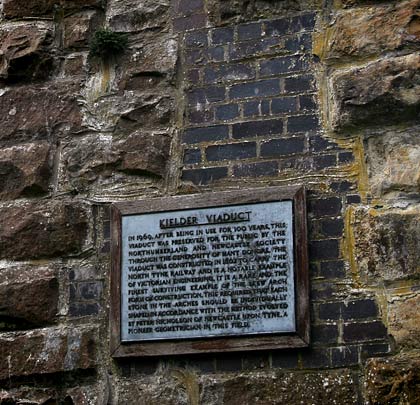Kielder Viaduct
Kielder Viaduct






















Kielder Viaduct was erected by the North British Railway between 1859-62 as part of an extension of the Border Counties Railway which the NBR acquired in 1860. Crossing the North Tyne, it helped to form a link between Falstone – reached by the railway in 1861 – and the Waverley route at Riccarton Junction.
Designed by John Furness Tone and built by contractors William Hutchinson and John Ridley for £4,572, its alignment is skewed to that of the river. As a result the masonry blocks from which the arches were built had to be cut to individual shapes such that they would lie perpendicular to the viaduct at the crown whilst aligning with the skewed piers at springing level. They were therefore laid along helical courses according to a set of principles attributed to Peter Nicholson, an architect and mathematician from Newcastle, who had devised a system to resolve such conundrums in about 1840.
Opening for goods traffic on 1st January 1862, the seven 40-foot arches carried their single line for 131 yards, at a height of 55 feet. In order to gain approval from the Duke of Northumberland, the local landowner, the structure had to be built in a Baronial style, decorated with a battlemented parapet and faux arrow slits. Subsequent repair work to the arch soffits and spandrels was carried out in engineering brick.
The line closed to passengers on 15th October 1956 and to freight on 1st September 1958. The last train to pass over the viaduct was a Hawick-Newcastle excursion of 7th September.
Having fallen into disuse, the structure was acquired by the Forestry Commission and was about to be blown up when the Northumberland & Newcastle Society (N&NS) stepped in to save it, paying a nominal £1 sum in 1969. Its deck was waterproofed and, for protection purposes, the three river piers had their bases encased in concrete when Kielder Water was built – work carried out by Wimpey Construction. The viaduct has subsequently been listed as a Scheduled Ancient Monument and further remedial works undertaken.
In 2004, the N&NS worked with the Kielder Community Trust to create eight decorative panels to be inserted between sections of parapets. These were forged by six master blacksmiths based on designs by community groups in Kielder village and local school children.
The viaduct now forms part of a network of paths around the lake and forest.







